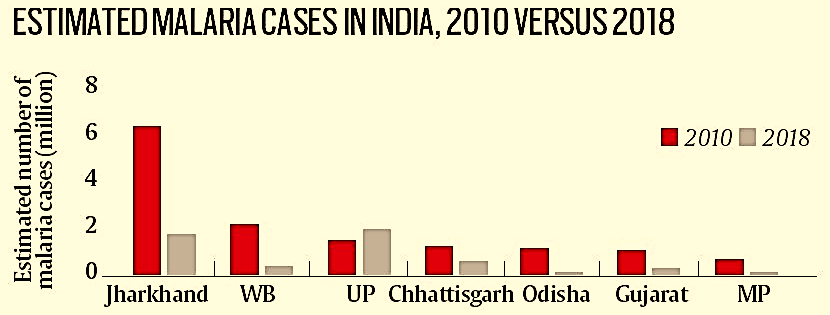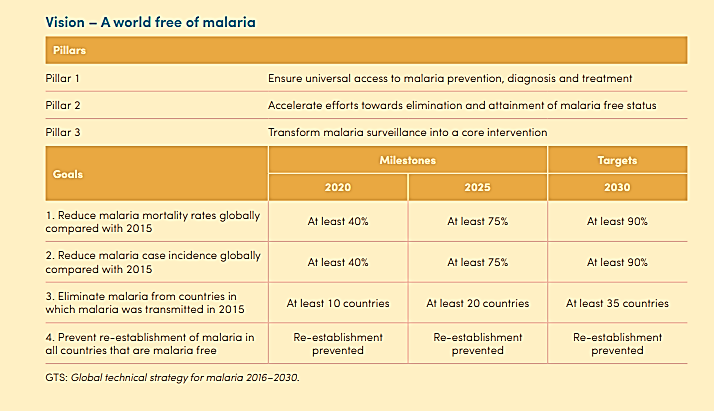World Malaria Report – 2019
- 07 Dec 2019
- On 4th December, 2019, the World Health Organisation (WHO) released the World Malaria Report, 2019, which summarizes global progress in the fight against malaria up to the end of 2018.
- This is the fourth world malaria report since the launch of the WHO Global technical strategy for malaria 2016–2030 (GTS).
- It is based on information received from more than 80 countries and areas with ongoing malaria transmission.
Major Findings
Global Specific Findings
- In 2018, an estimated 228 million cases of malaria occurred worldwide, compared with 251 million cases in 2010 and 231 million cases in 2017.
- Most malaria cases in 2018 were in the World Health Organization (WHO) African Region (93%), followed by the WHO South-East Asia Region (SEAR- 3.4%) and the WHO Eastern Mediterranean Region (2.1%).
- Six countries accounted for more than half of all malaria cases worldwide: Nigeria (25%), the Democratic Republic of the Congo (12%), Uganda (5%), and Côte d’Ivoire, Mozambique and Niger (4%).
- The incidence rate of malaria declined globally between 2010 and 2018, from 71 to 57 cases per 1000 population at risk.
- Plasmodium falciparum is the most prevalent malaria parasite in the WHO African Region,accounting for 99.7% of estimated malaria cases in 2018.
- Plasmodiumvivax is the predominant parasite in the WHO Region of the Americas,representing 75% of malaria cases.
- Globally, 53% of the vivax burden is in the WHO South-East Asia Region, with the majority being in India (47%).
- Children aged under 5 years are the most vulnerable group affected by malaria. In 2018, theyaccounted for 67% of all malaria deaths worldwide.
High Burden to High Impact Approach
- There were about 155 million malaria cases in the 11 high-burden-to-high-impact (HBHI) countries in 2018, compared with 177 million in 2010.
- India and Uganda have received a special mention from WHO) for their substantial reduction in malaria cases in 2018 over the previous year.
India Specific Findings
- In 2018, India saw a significant reduction – 2.6 million malaria cases – compared to 2017. Despite being the highest burden country of the WHO South-East Asia Region, India reduced its reported cases by half as compared with 2017.
- Only seven out of 29 States and seven UTs accounted for 90 percent of the estimated cases in 2018.

Source: IE
Significance of Report
- Providing Comprehensive Update: It provides a comprehensive update on global and regional malaria data and trends. The report tracks investments in malaria programmes and research as well as progress across all intervention areas: prevention, diagnosis, treatment, elimination and surveillance.
- Tracking Roll Back Malaria (RBM): It also tracks a set of indicators outlined in the Roll Back Malaria (RBM) advocacy plan, Action and investment to defeat malaria 2016–2030, to eliminate the menace of malaria.
- Highlighting Strategy against Malaria: The report highlights the various ways investment in the fight against malaria contributes to the SDGs and the aligned WHO “triple billion” targets of the 13th General Programme of Work (GPW13).
Initiatives towards Malarial Eradication
Global Initiatives
Global Technical Strategy(GTS) for Malaria, 2016–2030
- Adopted by the World Health Assembly in May 2015, the GTS provides a comprehensive framework to guide countries in their efforts to accelerate progress towards malaria elimination.
- The Strategy sets ambitious but achievable goals for 2030, including:
- Reducing malaria case incidence by at least 90%
- Reducing malaria mortality rates by at least 90%
- Eliminating malaria in at least 35 countries
- Preventing a resurgence of malaria in all countries that are malaria-free
- The strategy was developed in close alignment with the RBM Partnership’s Action and Investment to defeat Malaria 2016-2030 – for a malaria-free world to ensure shared goals and complementarity.
- It emphasizes the need for universal coverage of core malaria interventions for all populations at risk and highlights the importance of using high-quality surveillance data for decision-making.

World’s First Malaria Vaccine
- In April, 2019, African country Malawi launched the World’s first malaria vaccine,RTS,S/AS01 (RTS,S), developed by Glaxo Smith Kline (GSK).
- The vaccine is a complementary malaria control tool - to be added to the core package of WHO-recommended measures for malaria prevention, including the routine use of insecticide-treated bed nets, indoor spraying with insecticides, and the timely use of malaria testing and treatment.
High Burden to High Impact
- In May 2018, WHO along with RBM, called for an aggressive new approach- High Burden to High Impact, in order to accelerate progress against malaria.
- It is a country-led response to reignite the pace of progress in the global malaria fight.
- It aims to scale up prevention and treatment, and increase investment to protect vulnerable people from the deadly disease.
- The plan support nations with most malaria cases and deaths and is based on four pillars-
- galvanising national and global political attention to reduce malaria deaths
- driving impact through the strategic use of information
- establishing best global guidance, policies and strategies suitable for all malaria endemic countries
- Implementing a coordinated country response.
E- 2020 Initiative
- In 2016, WHO identified 21 countries, spanning 5 regions, that could defeat malaria by 2020, considering the likelihood of elimination across key criteria. Together, they form the E-2020 initiative.
- This interactive map provides the latest information on progress and challenges in these 21 countries on their path towards malaria elimination.
Indian Initiatives
National Strategic Plan for Malaria Elimination (2017-22)
- Launched in July, 2017, the plan gives year wise elimination targets in various parts of the country depending upon the endemicity of malaria in the next 5 years.
- It involve strengthening malaria surveillance, establishing a mechanism for early detection and prevention of outbreaks of malaria, promoting the prevention of malaria by the use of Long Lasting Impregnated Nets (LLINs), effective indoor residual spray and augmenting the manpower and capacities for effective implementation for the next five years
- Under this, elimination of malaria by 2022 has been envisaged for all 26 States including 15 low (Category 1) and 11 moderate (Category 2) transmission States/Union Territories.
National Framework for Malaria Elimination- 2016-2030
- The framework, developedin line with the WHO Global Technical Strategy for Malaria 2016–2030 (GTS) and the Asia Pacific Leaders Malaria Alliance Malaria Elimination Roadmap, encompasses a vision to eliminate malaria from the country and contribute to improved health and quality of life and alleviation of poverty.
Aims
- To Eliminate malaria (zero indigenous cases) throughout the entire country by 2030
- Maintain malaria-free status in areas where malaria transmission has been interrupted and prevent re-introduction of malaria.
Plasmodium Genus
|
Way Forward
- Malaria is a disease of poverty which exerts an enormous economic and social burden on the affected population groups, individuals and communities. The burden of malaria is highest among the most disadvantaged populations, particularly children and pregnant women.
- Global poverty and inequity are both a major cause and consequence of malaria. Efforts to prevent, control and eliminate malaria contribute toachieve the Sustainable Development Goals (SDGs) 3 - health and well-being for all.
- Further, achieving a world free of malaria will be accelerated by the successful adoption of Universal Health Coverage (UHC), which would provide everyone, everywhere with accessible, affordable, and sustainable health services.




